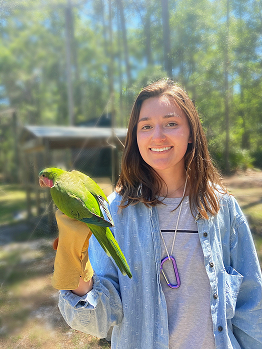Network attributes and aesthetics
Published:
Here I describe some basic aesthetics, and I show you how I incorportate attributes to my networks. Huge shout out to Liz Hobson for showing me most of these tips!!
Once you’re comfortable going from a dataframe (whether it is an edgelist or adjacency matrix) to a plot, it’s time to start thinking about aethetics! In my opinion, this is the best and most frustrating part. It’s fun because this is where your vision really comes together, and you can create a really beautiful network that is easy to interpret and visually appealing! However, it can be tricky forcing R to see your vision through. Thankfully, there are many packages and functions out there to help you out. You can use igraph or ggraph to plot networks. Which one you use somewhat depends on what you want to accomplish, but for this tutorial, I will be using igraph.
If I were to run the line igraph::plot(newtorkobject), igraph would output a very simple (but ugly) network. It would get the job done, but it would be difficult to interpret. Thankfully, igraph has many arguements that allow us to specify different aesthetics including the layout, vertex and edge size, color, and shape. You can manipulate label text and orientation. All this to say that networks can and should be highly customizable for your data.
GOAL: I am attempting to plot allopreening relationships among a group of 22 monk parakeets. Nodes correspond to birds, color represents the site they are from, shape represents sex. Edges represent allopreening relationship strength, so the stronger the relationship, the thicker the edge. In addition to my edgelist, I have a dataframe (df) called atts that contains a list of all individuals, the site they were captured from, and sex.
Make sure you have installed igraph before getting started!
install.packages("igraph")
library(igraph)
I also skipped some important pre-network steps, so if you’re confused, go check out earlier tutorials! This tutioral is for aesthetics only
First, I convert my edgelist to a network object called graph with the function graph_from_data_frame() (line 103). Here is where I tell R to reference my attributes dataframe. I do this with the arugement vertices =. Now, my network object contains actors, subjects, a count of their interactions, site captured, and sex.
In lines 106-115 (Fig 1), I am essentially selecting the vertices, or nodes, of a particular site_captured, creating a new column called color, and assigning them a color (i.e . #D7191c). I do the same with sex, but instead of assigning a color, I assign each sex to a shape. You can use the function: get.vertex.attribute(graph, "color") to double check!
TIP: Be considerate about the colors you are using, particularly for our colorblind friends. Here is just one of many helpful resources for helping you pick a color pallet that is inclusive!

I also want to color the edges black between birds from the same site and blue between birds of different sites (Fig 2). This gets slightly trickier, but we are using the same logic here. First, I create a column in graph called site (see line 118), then I create a list of birds from each site (lines 119-122). On line 125, I specify that I want all edges to be blue, but lines 127-130 I specify that I want edges between birds in the lists I just created to be black.

Now, I’m ready to plot! I’m using the igraph function plot().
First, I’m going to specify that I am plotting my network object, called graph (Fig 3). I use the layout = arguement to force a layout. Here is a description of some basic layouts. Next, I am going to specify what I want my vertices to look like with arguements like vertex.color, vertex.frame.color, and vertex.shape. This is where I am going to reference the columns I created in my network object earlier. I will do the same for my edges and specify that I want the width to correspond to the number of times the verteces interact (to depict relationship strength). It’s a personal preference and depends on what you’re plotting, but I like my network edges curved! If you don’t specify edge.curve, the default is staight. Lastly, I format the position of the labels relative to the vertex and the color. I also set the title with main =.

Finally, print(netXbin) outputs my network.

I hope this was helpful! Remember, when you find yourself fighting with R and you just can’t get something to work, Google it. Odds are someone has worked through a similiar problem and graciously posted their solution. Websites like Stack Overflow are extremely helpful for getting you started or finding inspiration. You can then adapt posted solutions to best serve you. This is exactly how I worked through many issues.

